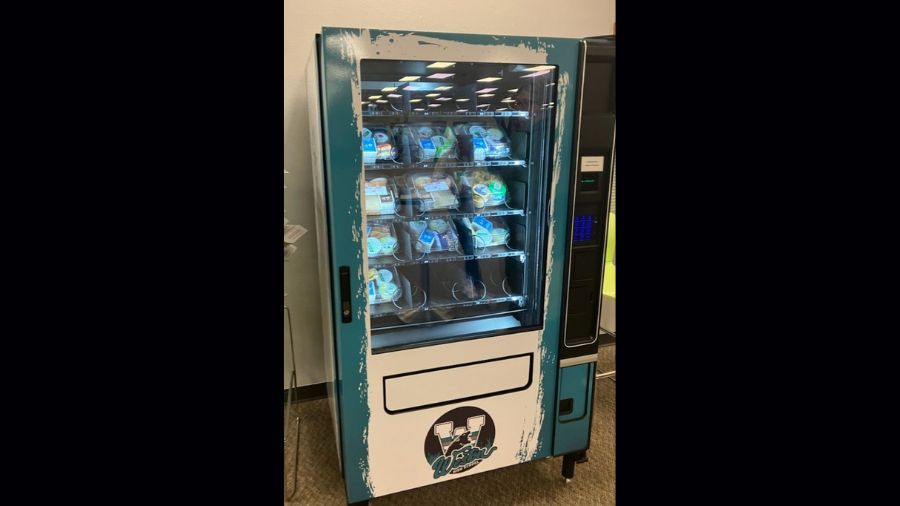King County deputies defend controversial use-of-force tactic
Oct 8, 2014, 2:20 PM | Updated: Feb 9, 2015, 1:37 pm

Lakewood Police Det. Jeffrey Paynter, a certified defensive tactics instructor, applies a Lateral Vascular Neck Restraint (LVNR) to his colleague, Officer Brian Markert, as Officer Thomas Arnold watches on. The use-of-force tactic has come under fire in recent month from civil right activists and members of the community who say it is too dangerous and amount to lethal force. (Photo: Brandi Kruse/KIRO Radio)
(Photo: Brandi Kruse/KIRO Radio)
His arm around my neck, Detective Jeffrey Paynter began to squeeze.
My vision narrowed. My eyes started to water. As he applied more pressure, blocking the flow of blood to my brain, I began to lose consciousness.
“All right, all right,” said another Lakewood police officer, signaling for Det. Paynter to release his hold.
I had just been exposed to a Lateral Vascular Neck Restraint – a controversial use-of-force tactic that has drawn criticism from civil rights groups who say it’s too dangerous and amounts to lethal force. King County Sheriff John Urquhart announced last month that his department would not move forward with plans to train deputies in the tactic, citing public backlash.
Some within the department are now speaking out against that decision, calling it hasty. Experts say the tactic – when used by trained professionals – is a safe and effective alternative to more dangerous options.
“I thought it was the sheriff caving to political pressure from a vocal minority in the community,” said a King County deputy, who agreed to be interviewed on the condition of anonymity.
“Not every situation is the same, and having extra tools to be able to solve problems is what we need.”
‘Efficient, effective, and ethical’
The Lateral Vascular Neck Restraint (LVNR) works by reducing circulation of blood to the brain. Officers apply pressure to the carotid arteries on either side of the neck, increasing the amount of pressure until a suspect either stops resisting or loses consciousness.
“I stand behind it as a technique that’s going to result in maximum control and minimum injury to officers and suspects,” said Det. Paynter, who trains law enforcement officers at the Washington State Criminal Justice Training Commission. He said it takes new recruits about 12 hours to be trained in the LVNR and roughly eight hours for veteran officers.
Paynter and two of his colleagues, Officers Brian Markert and Thomas Arnold, agreed to demonstrate the LVNR for KIRO Radio last month at the Lakewood Police Department.
All three of the men are defensive tactics instructors.
Officer Markert rendered Officer Arnold completely unconscious to show the full capability of the move, although the officers said 80 to 90 percent of suspects comply before that point.
“Once you release pressure on the neck, people wake up very rapidly from it,” Officer Markert said. “In mere seconds, someone can go from being fully unconscious, to being awake – maybe not fully aware of their surroundings – but they will snap out of it very quickly.”
In their demonstration, Officer Arnold regained conscious within about five seconds.
“How are you feeling?” I asked him.
“Good!” he said with a slight smile.
“I believe in this technique, because I’ve made it work in the field,” Officer Markert said. “I really feel like if I had not used this technique at the time, it would have resulted in a much higher level of force being used – such as baton strikes.”
Detective Paynter said members of the public often confuse LVNR with a chokehold, which he said is different and much more dangerous.
A chokehold, he said, is deadly because it could crush the trachea and restricts a person’s ability to breathe, which may result in asphyxiation. A properly applied LVNR, he said, does not restrict airflow or risk crushing the windpipe.
“Many people might not understand that this technique is efficient, effective, and ethical and does not have a history of producing serious physical injury,” he said. “I believe that we save lives with this technique.”
‘Knee-jerk reaction’
King County Sheriff John Urquhart agreed that the tactic is effective and often less dangerous than other use-of-force options.
“If you don’t use this, what are you going to do?” Urquhart said. “You’re going to use your Taser. You’re going to use your nightstick. You’re going to use your fists. You’re going to use your elbow. You’re probably going to hurt somebody to get them into custody. ”
Urquhart pointed out that officers in at least 35 other agencies across the state are trained to use the tactic and his department was poised to join them.
In the fall of 2013, King County training deputies told Urquhart they thought the tool was valuable and sought his approval to start using LVNR for the first time in ten years.
“I looked into it, I talked to them extensively, and I agreed,” Urquhart said. “When trained properly, I think it’s a good technique.”
Earlier this year, 16 deputies were trained in the tactic and the sheriff’s office planned to train more this fall – that is, until Urquhart had a change of heart.
During a community meeting on September 10 at Tyee High School in Sea-Tac, Urquhart was bombarded by questions and complaints from the public, who called the LVNR a “chokehold” and demanded that the sheriff’s office not continue with plans to implement the tool.
Urquhart told the crowd deputies would not be allowed to use the restraint after all.
“If I can’t convince the community that a tactic that we are using is worthwhile, then we shouldn’t use it. It’s as simple as that,” Urquhart told KIRO Radio.
The decision doesn’t sit well with some in the department.
“It appears to be a knee-jerk reaction to pressure from the local group (that doesn’t) like anything we do regardless,” said a second King County sheriff’s deputy, who also spoke on the condition of anonymity. “A lot of research and planning went into this and it was wiped out after one meeting with a group of organizers who ambushed him with it.”
Urquhart disputed that notion. He said he came to the decision over a period of at least two weeks and discussed the issue with county councilmembers and the prosecutor’s office, among others.
A spokesperson for the King County Prosecuting Attorney’s Office confirmed that Urquhart and King County Prosecutor Dan Satterberg had informal discussions about the tactic, but that Satterberg did not give the sheriff any legal advice on the matter.
The sheriff did not consult with his deputies or the department’s training unit before making his decision.
Instead, two days after the meeting, a change of policy email was sent to deputies notifying them of the reversal:
This special order is regarding the discontinuation of the Lateral Vascular Neck Restraint (LVNR).
Effective immediately, deputies will not use the LVNR technique. This includes those who have been trained to use the technique.
Deputies shall not make any physical application or maneuver to the neck region that restricts blood or air flow (i.e. chokeholds, sleeper holds, carotid submission holds, Lateral Vascular Neck Restraint, etc.), except as a last resort to protect the deputy(s) or others from an immediate threat of death or serious bodily injury.
Any variations of these maneuvers may be considered deadly force when applied to the neck.
“The decision wasn’t based in facts and getting expert opinion, it was just based in public perception,” a King County deputy said.
“I don’t think that most segments of the public have been in a violent fight with a drug crazed maniac who’s trying to beat you to death in the middle of the night when you’re all alone. Many of our deputies have.”
‘I can’t breathe!’
James Bible, a civil rights lawyer and former president of the Seattle/King County chapter of the National Association for the Advancement of Colored People (NAACP), applauded the sheriff’s decision to change course.
“Even if it doesn’t cause death, it doesn’t mean that it doesn’t impact other facets of a person’s life and their ability to trust law enforcement,” Bible said.
He noted that there has been national outrage over similar police tactics following the July 17 death of a man in New York City.
Eric Garner, 43, died after being subjected to an apparent chokehold by an NYPD officer who was investigating him for allegedly selling cigarettes illegally.
The incident was caught on video and Garner could be heard yelling “I can’t breathe!”
According to the New York City Medical Examiner, Garner died of compression to his neck and chest. Pre-existing conditions such as asthma, obesity, and cardiovascular disease were contributing factors, the medical examiner said.
Detective Paynter with Lakewood PD said it is too soon to tie Garner’s death to a LVNR.
“I think that there’s a fact pattern difference in that case,” Paynter said.
“(LVNR) has been employed for over 40 years by the Kansas City Police Department and by numerous other agencies,” he said. “There has not been one death documented with thousands of street applications.”
Bible said there is no way for officers to guarantee that an LVNR can be applied as intended when a suspect is resisting arrest.
“It can’t be done perfectly when someone is struggling,” Bible said. “Someone that is struggling or passively resisting could be strangled and killed by this.”
Because of the risk involved, some agencies, such as the Seattle Police Department, consider the move to be deadly force and do not train officers in its use.
“We have multiple other tools that can provide the same result without the risk involved with LVNR,” said Det. Patrick Michaud, a Seattle police spokesperson. “We don’t say that officers can’t use it, but we do put restrictions on the situations in which it can be used by policy. When an officer uses LVNR there is a risk of death involved and that is something that we do not take lightly.”
Michaud said use of LVNR by a Seattle police officer would trigger a response from a force investigation team, “which would place it squarely in a category with results that include serious bodily harm and death.”
“I think it’s illogical,” Det. Paynter said the Seattle Police Department’s stance on LVNR.
“That’s essentially saying that I can compress your carotid arteries, or I could hit you in the head with a hatchet, and those two things are the same thing.”
‘He’s the boss’
“Just because a technique works, doesn’t necessarily mean we should use it,” Sheriff Urquhart told KIRO Radio during an interview in his office last month.
“Not everybody agrees with this decision, but it’s still my decision to make and I made it.”
Some deputies question his judgment.
“Obviously, he’s the boss. He gets to make the decision,” one King County deputy said. “But I think the decision should be rooted a little more in fact and experience, rather than just the outcry of some.”
Even James Bible with the NAACP said it appeared that the sheriff’s decision was made without much consideration.
“He seems to be in a place where he makes inconsistent decisions that aren’t based on thought, and I think that’s possibly where members of the rank and file might actually agree with the community at large,” Bible said. “When you just blurt something out in terms of a large policy change, it isn’t always based on a rational decision making process.”
The deputy told KIRO Radio that the decision could have dangerous consequences.
“In a day in age where the police are looked at to have more options for solving problems, and to not have this option available, it just takes away the ability of the police to perform their jobs in the best possible manner,” the deputy said.
“This tactic doesn’t just protect the police, it protects the public,” the deputy added. “When our officers don’t have a tool to be able to control somebody, and it’s getting very violent, all they have right now to resort to is shooting someone. I don’t think we want to see a shooting of an unarmed person by the police, especially the way things stand now in America.”
Sheriff Urquhart said he would reconsider training his deputies in LVNR if community members can be convinced that the tactic is worthwhile.
“KIRO Radio On Assignment” features in-depth, investigative reports on a variety of topics including government accountability, consumer advocacy and the criminal justice system. To send a KIRO Radio reporter “On Assignment,” email onassignment@kiroradio.com or use our online form.












